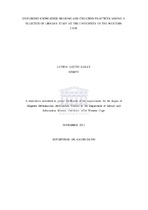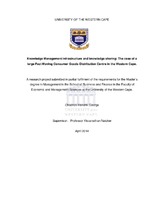| dc.contributor.advisor | Davis, Gavin | |
| dc.contributor.author | Lekay, Letitia Luette | |
| dc.contributor.other | Dept. of Library and information Science | |
| dc.date.accessioned | 2014-03-06T13:48:46Z | |
| dc.date.available | 2013/04/10 | |
| dc.date.available | 2013/04/10 11:13 | |
| dc.date.available | 2014-03-06T13:48:46Z | |
| dc.date.issued | 2012 | |
| dc.identifier.uri | http://hdl.handle.net/11394/2920 | |
| dc.description | Magister Bibliothecologiae - MBibl | en_US |
| dc.description.abstract | The aim of this study was to determine whether or not knowledge was shared and created in the library of the University of the Western Cape (UWC). The study adopted the SECI model of Nonaka and Takeuchi (1995) as its theoretical framework. The service delivery points at the UWC library are as follows: Circulation section, which deals with walk-in users. These are users who, on a daily basis borrow books from and return books to the library. This section normally deals with queries such as users whose library cards are blocked due to outstanding library fines. It comprises front - desk staff, shelf attendants and inter-library loan staff members. Staff members working in the information section (IS) are referred to as faculty librarians (FAC/L’s), who are regarded as section heads and liaise with faculties on campus on a regular basis. The information section deals with walk-in users on a daily basis. The other sections, namely cataloguing, acquisition and periodicals, provide mostly ‘behind the scenes’ services, but their work is of such a nature that users have no access to their sections due to the strict policy with regard to areas of the library in which staff are working with new books and journals. Books and journals that are not on the cataloguing system are kept in the acquisitions and cataloguing section. This also has a significant impact on service delivery in the library. These sections have to ensure that books and journals are processed, in order for users to get access to these resources. This study attempted to answer the following research questions Is there evidence of knowledge sharing and creation in the UWC library? If so, what practices currently exist? How do staff share and create knowledge for service delivery not with general library users, but within and between the acquisitions, cataloguing and information sections? | en_US |
| dc.language.iso | en | en_US |
| dc.publisher | University of the Western Cape | en_US |
| dc.subject | Knowledge | en_US |
| dc.subject | University of the Western Cape | en_US |
| dc.subject | Knowledge-sharing | en_US |
| dc.subject | Tacit knowledge | en_US |
| dc.subject | Knowledge management | en_US |
| dc.subject | Explicit knowledge | en_US |
| dc.subject | Libraries | en_US |
| dc.subject | SECI model | en_US |
| dc.subject | Service delivery | en_US |
| dc.subject | Library services | en_US |
| dc.title | Exploring knowledge sharing and creation practices among a selection of library staff at the University of the Western Cape | en_US |
| dc.rights.holder | Copyright: University of the Western Cape | en_US |
| dc.description.country | South Africa | |




